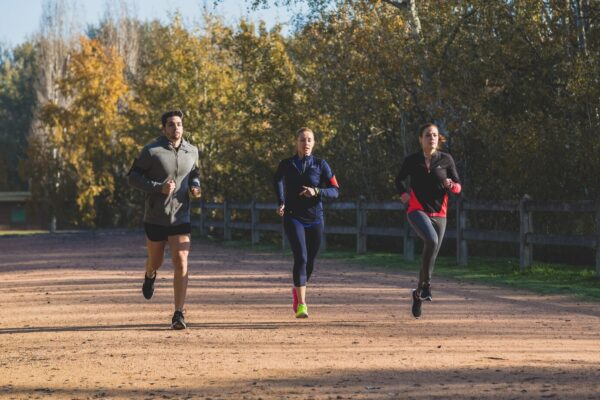What is endurance training? Many of us often ask ourselves what the various kinds of training are good for when following a running program. Have you ever questioned the purpose of specific training when preparing for a certain distance, such as a 5K or a marathon? Understanding the benefits of particular training can enhance your performance and experience. Let’s explore what you stand to gain with this post!

What Is Endurance Training In Running
Endurance is the most important factor in long-distance running. It increases cardiovascular fitness, and muscle endurance, allowing the body to perform at a steady running pace over extended periods.
The benefits of endurance training go beyond running performance: it strengthens the heart and lungs, improves circulation, and boosts energy levels. Over time, it helps the body use oxygen more efficiently, reducing fatigue and increasing overall endurance.
The ability to run at high speed doesn’t mean anything if you cannot maintain the pace of the planned distance. The longer the distance you want to complete, the more important it is to have great endurance.
Endurance is improved by gradually increasing the length of the running distance. So endurance training is about pushing the limit of how far you can run, whereas the speed at which you run is not the most important.
To perform at maximum pace in long-distance running, it is therefore necessary to use a significant part of the training on endurance training. So, to improve your endurance, You need to run long slow distances (LSD). The pace and the length of your chosen running distance depend on your basic shape – your current running level.

The Two Main Types Of Endurance Training
In short, we divide endurance training into two main types. Aerobic training is long-term training where you run at easy to moderate intensity. The body uses oxygen to make energy here, so you can maintain a steady pace.
Anaerobic training is short and intense training such as sprinting. The body does not get enough oxygen, so it makes energy without oxygen and produces lactic acid as a waste product in the muscles.
Aerobic endurance training
So, Aerobic training is about improving circulation, also called the central factors, including the heart, lungs, and blood circulation. Fat and carbohydrates are converted during this type of training, through combustion with oxygen consumption.
Here, you will work on improving the body’s performance in relation to the production of energy through the consumption of oxygen, but also for better absorption of oxygen in the body. This applies both over longer periods, but also more generally.
This means that the pace is higher but adapted to your running level. The limits of the muscles are pushed to absorb as much oxygen as possible and create as much energy as possible throughout the body.
Distance running at an easy to moderate pace (LSD), for an extended period is a classic form of aerobic exercise. You train your aerobic capacity.
Anaerobic endurance training
In this type of training, explosive energy is created in the body without the use of oxygen. The intensity of the training is very high, and therefore, there is not enough oxygen available to create this energy.
Anaerobic endurance training called AT – training (anaerobic threshold training) will create an accumulation of Lactic acid, a waste product that you will experience as a burning sensation in your legs.
By doing AT – training 1-2 times a week depending on your current level, you increase the length of the period in which the body and muscles can perform at their maximum. This means more intense and hard training for short periods, usually as interval training with breaks in between.
It’s a matter of training intensity

We have to look at the intensity of the training to determine which system is most active. One of the most important differences between the aerobic and anaerobic energy systems is the rate at which energy is produced.
The anaerobic system delivers energy significantly faster and will therefore deliver a larger portion of the energy when the intensity is higher. So when you sprint e.g. 60 meters with everything you have, almost all the energy will come from the anaerobic processes, and you probably won’t even have time to breathe.
How To Enhance Your Performance
In general, your body gradually gets used to new stimuli, i.e. load and way of moving. The body will adapt to the new load patterns or stress according to the SAID principle – Specific Adaptation to Imposed Demand – meaning your body adapts to the specific demands placed upon it.
If you train for a particular running distance, your body will adapt and be better at that specific distance. Consider this principle before you start a running project.
To improve your performance it’s crucial to know your current running level. It is also necessary to adapt the training distance to the distances you choose to compete/participate in. If you want to participate in a marathon, it is not enough to train at distances up to 10 km.
You have to build up the length of the distance gradually, and slowly accustom the body to the long runs. The intensity of the long runs must be at a pace we call talking pace. You can use the Borg Scale to find your steady pace.
A better way to find the pace or intensity is by using a heart rate monitor. Your heart rate should be between 60 – 80% of your maximum heart rate. When you run long distances with this load, the body will slowly adapt to this new challenge.
Physiological changes will occur in the heart, blood circulation, muscles, tendons, and bones and you are on your way to becoming a better runner.
Manage your endurance training
A training program is a good idea if you want to control your progress, avoid running into annoying overload injuries, or lose motivation. You can find a training program that starts with your current running level. This training program can be your blueprint to start running and for your progress.
In general, the training program’s structure and content must consider whether you are a beginner or experienced. A runner who is training to run just one 10km race should train differently than a runner who trains hard to improve on an already good 5 km time.

Training methods for endurance
Training programs should be specifically designed for you and your chosen running distance. Depending on the purpose, many different training methods can be combined in many different ways. The training methods can again be grouped into categories.
There are 6 categories when we look at the most relevant. That also includes recovery and cross-training. These categories are particularly important for performance at distances from 5 km up to the marathon distance.
The Various Running Training categories
In basic, endurance training is about developing enough endurance to be able to maintain the necessary speed at the entire distance, you want to complete- or compete at. But endurance training is a broader concept in running because several other elements contribute to your performance and a great time in distance running.
Most running coaches today will say that the training must be varied and contain many different forms of training if you want to see improvements and increase your overall endurance on a given distance.
For many runners, there is an untapped potential by “mixing” several different forms of training in relation to the goals set for the individual runner. Doing that in the right way is something that really enhances your performance.
The different training categories listed below all contribute in various ways to a better performance. They are not equally relevant and significant to all running distances but the 5 first should be included in the training regardless of whether the goal is the 5 km distance or a marathon race.
- Lactic acid threshold training (AT – Training)
- Maximum oxygen uptake, Fitness rating (VO2 max.)
- Endurance, LSD
- Strides
- Recovery
- Cross training
AT – Training

When you only train endurance on LSD distances, you will be able to run far and in a long time. With Anaerobic threshold training (AT) also called lactic acid training, you will be able to run faster on your LSD distances.
The lactic acid threshold describes the time, or intensity at which the body can no longer eliminate lactic acid as quickly as it is formed. Your performance begins to drop, and you have to slow down.
Anaerobic Threshold Training, AT – Training is the most important form of training for long-distance runners who want to improve their performance. To move the lactic acid threshold, your training must be carried out with an intensity around the lactic acid threshold, 80 – 90 % of max. effort. Interval training or tempo runs are often used for this training.
Maximum oxygen uptake
The maximum oxygen uptake VO2 max. aims to improve your oxygen uptake by transporting as much oxygen out to and into the working muscles as possible. So VO2. max. describes how good you are at producing energy using oxygen.
VO2 max. is trained by running intervals with a very high heart rate, 90-98% of max. effort. We cannot maintain such a high intensity all the time on a run. Therefore, we often use interval training to divide the runs into smaller parts.
Interval training is performed by running at a high intensity for e.g. 3-5 min. followed by a break of 2-3 min. then run at high intensity again, etc. until you have completed all the intervals that you have decided.
It is primarily short intervals with high speed and intensity that stimulate VO2 max. (also called fitness rating).

Endurance – LSD
The benefits of endurance training include improved heart health, greater lung capacity, enhanced metabolic rate, increased stamina, and better mental resilience. It’s a key component in training for all sports that demand sustained effort over time. So how do you do it in running?
To improve endurance, you have to run long slow distances – LSD as the main factor, the cornerstone to get in better shape for distances from 5k to marathon.
The pace and distance depend on your basic shape – current running level. If you run with an intensity of 60 – 80% of your max. effort, you will load the body with the desired stimuli and it will adapt to this training. Physiological changes will occur in the heart, blood circulation, and muscles. You become a better runner.
Strides
Strides are short periods of faster running. the exact definition depends on who you talk to, but many coaches agree that strides are at about 85 to 90% of your max. effort covering around 50 to 150 meters (or 15 to 30 seconds) of running at this “fast” speed and then going back to easy jogging before the next stride.
It will make you a more efficient runner. With short bursts of faster-pace running, you teach the body to move more efficiently with new movements. It also provides variety compared to the long LSD training periods up to a marathon, which can become too one-sided.
They are also good as an introduction to the more specific interval runs if you are a beginner or never have tried this form of training before.
Recovery
The need for recovery increases in line with the training intensity. This is very important to remember when following a running program. Recovery is of utmost necessity to give the body the opportunity and time to rebuild itself when the training is over.
The body doesn’t become stronger from the training itself. It’s the recovery period after training that makes the body stronger than before you started training. Depending on the intensity, you should expect 24 – 48 hours before the body is ready again for the next training session.
Cross-training
Cross training means that you add various other activities to your training routine. In this way, you allow the body to recruit other muscle groups than your primary activity. Listed below are 4 suggestions for why you should use Cross training as a supplement to your primary sport.
- Cross training can increase your performance with mobility, flexibility, power, agility, endurance, and balance.
- If you combine training that complements your main sport with e.g. strength training exercises or pilates to support your goals, it will help you develop a higher overall fitness level.
- Cross training can also help you break the monotony, create variety, and allow you to regain enthusiasm for your preferred sport.
- If you only run all the time, you risk developing weaknesses in part of your body. It’s these weaknesses that lead to injuries. Cross training can develop other “support” muscles and prevent injuries.
- If you have a smaller injury, cross training can help you stay in shape while you recover from the injury. Use e.g. Elliptical trainer in a gym. It is very gentle on tendons and joints and works very directly on the Cardio system.

Your Personal Training Program – Benefits
A training program is a plan for how you train toward a goal such as a 5k public race in the future. The aim is to structure your training so you get the most out of it. It creates an overview, provides motivation and you are sure to make progress and reach your goal.
It can also help to prevent injuries and help reveal whether the training is too hard or too easy. The above categories are used in varying degrees depending on your current running status and which distance you choose to run.
So, when you have signed up for a public race in the future, with a personal training program, you can get rid of all worries about whether you’ll be able to get in shape for the race day.
As long as you just follow the program from start to finish, you can relax knowing that you have devised a plan or consulted a coach to create a running program for you that will get you to the start line and further to the finish line.
Final thoughts
Now you know endurance training and running performance have more elements than just running a certain distance. The main factors are the heart’s Circulation system and lung function. Next, the local factors out in the working muscles with lactic acid tolerance and other physiologic aspects.
Pure endurance is not enough to enhance running performance. Therefore, the training plan must include other types of training, which are used in varying degrees in relation to the running distance you choose.
I hope you get something out of this post. If you have any questions about the topic or want to leave your review, please leave a comment below.






Hi and thanks for this. It took me back to my Firefighter training days when building my endurance was a big part of meeting the high fitness levels for the London Fire Brigade.
I remember doing a lot of aerobic endurance to be able to deal the longer physical demands, but anaerobic training was also important too, especially for the quick bursts of high intensity which I needed during drills.
Although I was quite a good runner, it was not something I loved, especially the long distances. For example I do not know how those people who choose to do marathons can endure the distance for such a long time.
Yes I was fit, but not that fit!
Thanks again, I think this is a good place to come for people looking to improve their training!
Chris
Hi Chris
Thank you for the comment and your personal story as a former firefighter.
We don’t necessarily have to be great at endurance training.
But good enough to meet the physical challenges and knowing what aerobic and anaerobic demands mean in our job, as you write so well, will be beneficial.
Be Well
Henrik
As a 70-year-old, I’m eager to understand the specifics of endurance training and how it can benefit someone my age. Could you provide detailed information on the types of endurance exercises suitable for septuagenarians, the recommended frequency and intensity of such workouts, and any precautions or modifications that should be considered to ensure safety and effectiveness?
Hi Catherine Ford
Thank you for the comment and your questions.
You can exercise regardless of your age or physical condition. As a 70-year-old, you can probably benefit most from putting together 3 different training programs: one program that focuses on strength training, one that trains your heart rate, and one that trains mobility and balance. You are not supposed to do all the programs at once. Try one program at a time – maybe a new one every day. Use YouTube and search for example Physical exercises for 70+
Be Well
– Henrik
This post on endurance training provides a great breakdown of how to improve running performance through both aerobic and anaerobic methods. I particularly appreciate the emphasis on the importance of gradual distance increases and how your body adapts over time. The distinction between aerobic and anaerobic training really helps in understanding how each contributes differently to endurance. What strategies do you recommend for beginners who are just starting to incorporate these training methods into their running routine?
Hi Hanna
Thank you for the comment and your question.
Recommended strategies for beginners could be:
Running motivation is essential – your why do it?
Previous training experience ex. From other sports to find your current running level.
Set realistic running goals – maybe sign up for a short public race in the future.
Buy a pair of great running shoes.
Follow a beginners running program to manage and measure your progress toward your goals.
Many newbies choose a running group to feel the team spirit and keep up the motivation.
Be Well
– Henrik